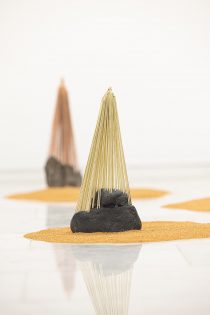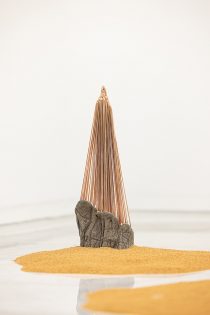The Shape of Ginger _ Park Cheonwook, 2015
|
The Shape of Ginger
We have not been with the beginning of “art.” Art had already begun on the foundation of art history, artists, and society. Art, which has begun in a shape determined by others, cannot be free. In any case, even when artists construct their own art world regardless of previous art, they would not be truly free since they are to be evaluated within the “art.” With the advent of contemporary art, artists succeed art activities in search of a new frame by expressing their creativity and originality within the frame of various discourses, techniques, meanings, and social backgrounds. They are then evaluated, and the evaluations are relative. Absolute evaluations are sometimes expected in art, but reality does not work that way. The standard for value changes, and it is relative. How is the standard determined? In contemporary art, the standard seems to become more obscure.
The shape of ginger is not defined. To the question “What does ginger look like?” no definite image comes to mind. However, the function and use of ginger are clear, and gingers take on various shapes. The topography of art cannot be drawn easily at first thought, so it is postulated in the shape of a ginger. Likewise, it metaphorizes that art clearly exists, yet the shape of art is obscure. Exhibitions have been planned from outside SeMA Nanji Residency. Each year, several artists apply, and residency artists are determined according to a certain standard. Selected artists come to think that their art world is “recognized,” with the unselected artists starting to ask what kind of standard was used.
The profile of artists is evaluated. A list of art activities, such as solo exhibitions, group exhibitions, contests participated in, collection of artwork, awards, and residency, is specified. The content is also a kind of “recognized” record by somebody. Then, let us review “undisclosed” art activities. Failed art activities……. The art world of an artist may be recognized at an event, but not at other events. This, of course, can be attributed to the fact that elements such as the preference of a contest host or social background may have been influenced by or attributed to the artist’s prior art activities in terms of quality and quantity. That alone cannot suffice as explanation, however. Dissimilar results of the same portfolio, which is applied to different contests during the same period, may not be enough to say that a failed record is a result in contrast to a successful record. In other words, success and failure are not in opposite directions; rather, they are simply determined by a criterion. Artists who see this exhibition from the perspective of viewers may be able to get temporary solace from the failed artists who became the subjects of this exhibition. Nonetheless, solace cannot be a solution.
Our common beginning would be art for college entrance. How much would the art techniques acquired for college entrance differ from contemporary art? Artists attempt to investigate the relationship between their early art and contemporary art. Artists who participated in an art test drew or made a ginger sculpture, which symbolizes contemporary art, in a college art method with which each artist began. Is there any relationship between their college art skill and their present ability as an artist? Is there an interrelation between their early art and their present art activities and expressions? We start to think how the evaluation criterion applied to an artist has changed over the period from college entrance art to contemporary art, what the criterion is, and whether the criterion has been simply changing like fashion.
Even though we do not know who operates art, art probably begins from artists. Museums of art and cultural foundations can exist when artists exist. However, the situation has been reversed: in contemporary art ― artists can exist when museums of art exist. Within contemporary art, artists must be recognized for their artistic ability, and they can survive when the public and national museums of art buy their artworks and provide workplace and exhibition funds. Korean contemporary artists cannot survive easily without national and public museums of art. The evaluation criterion seems to become obscure, yet every aspect of artists is under evaluation.
Exhibitions are basically for “artists.” Artists participating in exhibitions have come to participate in exhibitions in a way that is totally different from their art world. The exhibitions are intended not to allow artists to draw the shape of art in their own way, but to present the shape of art that has been drawn, regardless of their intention. Artists try to “consume” exhibitions that have been planned with the assistance of national and public museums of art, rather than as “producers” of art with assistance from national and public museums of art. The exhibitions will offer a party for artists to enjoy on the opening day; they are also concrete and explanatory. Contrary to the present situation of the contemporary, which leaves open the possibility of interpretation, the exhibitions suggest tests in a concrete way and in an imposing style. Even if this may seem a coward metaphor, interpreting obscurity will take a long time. The intent of exhibition planning will suffice by simply acknowledging the fact that the standard of evaluations is obscure, and that nobody actually knows what the standard is like. Park Cheonwook (Artist) |









